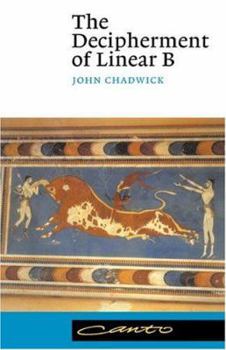Book Overview
In revealing the secrets of Linear B it offers a valuable survey of late Minoan and Myceanean archaeology, uncovering fascinating details of the religion and economic history of an ancient... This description may be from another edition of this product.
Format:Paperback
Language:English
ISBN:0521398304
ISBN13:9780521398305
Release Date:November 1990
Publisher:Cambridge University Press
Length:180 Pages
Weight:0.50 lbs.
Dimensions:0.6" x 5.5" x 8.5"
Customer Reviews
5 ratings
Good summary of the decipherment story
Published by Thriftbooks.com User , 20 years ago
I really liked this book as an outline of the method used to decipher the Linear B script found at Crete and a few locations on mainland Greece. The author is very well qualified to comment on the decipherment given that he was a key collaborator with Michael Ventris. I found the level of detail to be just right to show the outstanding scholarship achieved by Ventris who was a professional architect, not a Greek Classics college professor; but not so much detail as to detract from the readability of the story.
A detective story
Published by Thriftbooks.com User , 22 years ago
When he excavated the Minoan city of Knossos in 1900, Arthur Evans found clay tablets containing an unknown language which he named Linear B (he also found variants he named 'hieroglyphic', Linear A, and Linear C). Evans himself began the decipherment process. He discovered that the tablets were palace records and deciphered their numbering system. Since there were about 90 different symbols, he noted, correctly, that the symbols represented syllables rather than alphabetic characters (too many symbols) or ideograms (too few symbols). Beyond these observations, little progress was made until, in 1952, half a century after Linear B was discovered, Michael Ventris announced that he had discovered the means to translate it. John Chadwick tells the story of Linear B. Not to denigrate the achievement of Champollion's success with Egyption heiroglyphs, Linear B had no Rosetta Stone. It had to be understood soley from the internal evidence of the tablets. The book describes early "solutions" that were guesswork based on untenable analogies or theories. Ventris proceeded differently. The reader becomes amazed at his abilities (he memorized complete texts of symbols before understanding what they meant), his insights, and his thoroughly analytical methodology. The book tells in loving detail the steps leading to the solution. You almost feel you are taking those steps yourself and a sense of excitement grows as you see pieces falling into place. He builds a grid of vowels and consonants and painstakingly fills the symbols into their places. He finds words, and you share in the process of discovering they are an early form of Homeric Greek used in Mycenaen times at the end of the Bronze Age. Beyond the decipherment, the book tells what we have learned from the tablets about life, economy, trade, agriculture, and armies of Mycenaen Greece. This book is not only for people interested in the Greek language and history, it is also a fascinating detective story of the solution of an incredibly complex puzzle.
Outstanding History!
Published by Thriftbooks.com User , 24 years ago
This book is one which has an extremely interesting description of the methods used in and the results of deciphering clay tablets which contained what was finally determined to be ancient Greek. I have gone back to reread large parts of it several times, because it is concisely packed with so much information about the development of the Greek language. It contains facts which tell much about Greek history. Did you ever wonder why, compared with other ancient cultures, there are very few Greek Linear B tablets from which to glean information? This scarcity of source material is one of the reasons that Linear B was so hard to translate. This book has the simple but very significant answer, along with glimpses into other cultural traits of the times. It is not a thick book, but what John Chadwick has written speaks volumes. Well worth reading for someone interested in the Greek language and culture.
Seminal
Published by Thriftbooks.com User , 24 years ago
An absolute must read for people who want to see the fascinating process by which ancient scripts are deciphered. Also points out that to begin to understand the classical world, one must begin with the bronze age. I only wish someone would do a reprint of this book with actual linear B characters in the text itself, rather than numbers
A discover that made European history 1,000 years longer!
Published by Thriftbooks.com User , 26 years ago
Michael Ventris was a young British architect who, during Word War II, serviced in the RAF Intelligence Office, deciphering German encripted dispatches. Defeated the nazis, he started his very own personal "war" against a new "enemy". The "encripted dispatches" were now the incribed clay tablets of the Mycenean civilization, in "prehistoric" Greece. After a few years, Ventris eventually announced to the word that he "cracked" the ancient Linear B script contained in the Mycenean tablets: they were accounting records, and the language contained in them was an archaic form of Greek! John Chadwick was the first scholar who believed in this discover and, with his help, Ventris won the skepticism and prejudice of the academic world. Thanks to Ventris' decipherment, the beginnig of European written "history" has now moved backwards by nearly one millennium!





